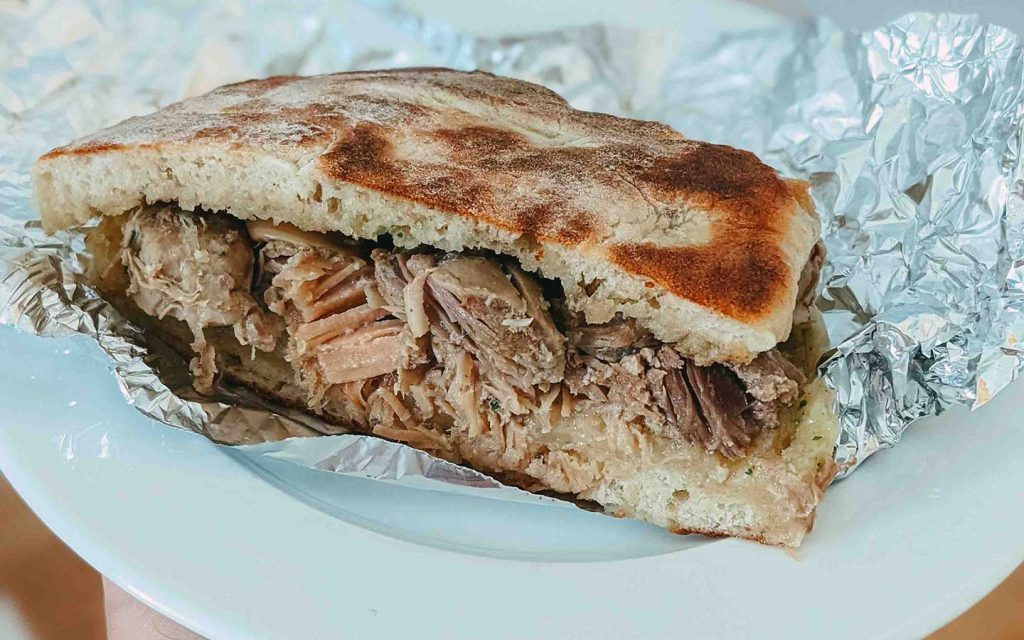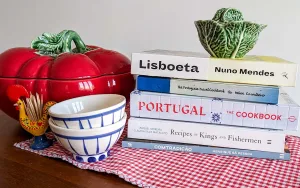The beauty of travelling around Portugal is eating through the huge variety of regional dishes, local sweets and unusual. From the north to the south, and out to the remote islands there are so many unique things to try. Here’s a round-up of the best Madeira dishes, foods and drinks you should try while exploring the island – use this guide as a partner to my blog on where to eat and drink on Madeira Island.
Some of these dishes you might be able to find on the mainland, but frankly it’s quite unlikely so get educated and load up on milho frito and poncha while on Madeira or Porto Santo islands.
Contents
ToggleBolo de caco
Essentially a pan-fried round bread. Most commonly served with garlic butter as a starter or side. It’s also popular for sandwiches. You can find it almost everywhere, so order often.



Milho frito
Fried herby polenta cubes. You can order this as a side at many places and they will likely be pre-made and frozen. The best we had were homemade at O Moinho, detailed below.

Peixe espada preto
Venture to the fish market in the centre of Funchal and you’ll long black ugly fish overhanging the marble benches. That’s peixe espada preto or black scabbard. You’ll often find this fish on menus cooked up with banana.


Espetadas
Tasty, tasty meat skewers. Madeira is famous for its oversized kebab skewers, the difference here being the use of bay laurel branches or stems as the stick or skewer. These days it’s more common to find metal skewers but there should always be salt, pepper, garlic and bay leaf in the seasoning before the skewers are grilled over wood or charcoal. The skewers are huge and restaurants that specialise in espetadas will have iron structures on the table just to hang them.



Read all about Talho do Caniço, my favourite place for espetadas, with this in-depth run-down.
Picado
Essentially chopped steak with gravy, usually served with chips. Hard not to love.
Lapas
Both Madeirans and the Azoreans love to eat these conical sea barnacles. Expect them grilled with butter and garlic on a sizzling hot plate. When they’re good, they’re fantastic.
Find out where to eat limpets and more in my where to eat in Madeira guide.


Tuna
Wander the fish markets and you’ll see mostly two fish: the ugly snake-like black scabbardfish and huge tuna being sliced up like steaks. When on the island, order tuna where and when you can. We had it a couple of times and it was tasty but often overcooked.
Octopus
Polvo is great anywhere and Madeira is no exception. We enjoyed it a couple of times sandwiched between bolo de caco, chopped and marinated like a salad.


Sopa de trigo
Hearty and wholesome, this soup is more of a stew with cracked wheat, beans and cubes of potato, carrot and more floating in a rich, porky broth. Heavenly.
Sopa de tomate e cebola
Madeira’s traditional tomato and onion soup is so delicious. If you see it, order it. It should arrive with a poached egg floating on top.
Carne vinha-d’alhos
Look out for this dish of pork soaked in wine, vinegar, garlic and bay leaves. We had it a couple of times sandwiched between garlicky bolo de caco for a quick, cheap lunch.



Madeiran bananas
The island of Madeira is covered with banana trees so make sure you try the little yellow bananas. They’re a little smaller and sweeter than the South American ones commonly imported to Europe.
Tropical fruits
A subtropical island means tropical fruits, but let this be a warning: The main fruit market at Mercado dos Lavradores in Funchal deeply disappointed me and felt rather deceiving. You’ll see beautiful artisanal local baskets stacked up with colourful exotic fruits – but look closely as the labels for most fruits say Colombia, not Portugal or Madeira. I was warned about some dodgy vendors adding sweetener to sour tropical fruits to sell them to tourists at exorbitant prices but not that the fruit wouldn’t actually be local. This Portuguese island does have local fruits – bananas, some types of passionfruit, tangerines, crab apples – but not all these items on display. The prices are highly inflated.



More Madeira – What to eat and drink in Madeira: the best local dishes to try
What to drink on Madeira
Poncha
Poncha is a delicious drink, until the next day. A rough mix of sugar and lemon rind, Madeiran rum and fruit juice, this strong and potent punch packs just that. More than two small cups and you could be in serious trouble. Try all four main types of poncha – the traditional fisherman’s (pescador) poncha with just lemon juice, the regional with orange juice, passionfruit (maracujá), or tangerine (tangerina).



Madeira wine
Dating back to Portugal’s Age of Discoveries, ships travelling to the East Indies would stop by Madeira for supplies, leaving with barrels and barrels of the local vinho. After crossing the equator a number of times, they realised the wine tasted better after the brutal heat of the journey. Madeira’s fortified wines are now stored in attics, instead of cool wine cellars. There are half a dozen brands to try while on the island including Blandy’s, Henriques & Henriques, H. M. Borges, Justino’s, Pereira D’ Oliveira, and Barbeito.

Madeira rum
You can’t have poncha without rum. Making use of the island’s sugar cane production, there is plenty of agricola rum made here. If you visit between March and May, like we did, make a stop by Engenhos do Norte where they were processing the cane with steam-powered machines from the 19th century. I love seeing how food is made or produced, and this was one of the coolest (and free) experiences.



Nikita
Is it a milkshake or a cocktail? One thing’s for sure, it’s weird and delicious. The frothy drink mixes pineapple ice-cream with pineapple juice and beer. Some spots add wine. Much tastier than it sounds.
Brisa
This is a local soft drink and I love it. Passionfruit is the OG flavour and I think this is what’s needed to ward off any next-day poncha hangover.
Okay, now you know what to eat, go read my guide on where to eat and drink on Madeira Island. While you’re at it, explore my five-day Madeira itinerary.













